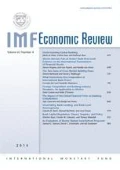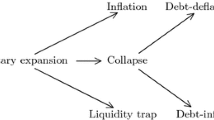Abstract
This paper analyzes an economy in which debt overhang occurs simultaneously in the mortgage market and in the market for bank debt. Overhang in one market reinforces overhang in the other. In a closed economy, it is ex post Pareto-efficient to tax households and recapitalize the banks. In an open economy, however, some of the gains are transferred abroad, whereas all the costs are borne by domestic households. Efficient recapitalization programs therefore require global coordination.




Similar content being viewed by others
Notes
See Bulow and Shoven (1978), Grossman and Hart (1980), and Gertner and Scharfstein (1991). Contract incompleteness can also be an impediment to renegotiation as argued by Bhattacharya and Faure-Grimaud (2001).
See Tirole (2006) for a complete overview of this literature.
Note that in this case, banks are indifferent between investing and not investing. As projects are indivisible at the microlevel, a fraction of banks invest x=X, while the remaining banks invest nothing. The fraction is such that the equilibrium condition x̄=ȳ1 is satisfied.
(r/(r−δ)−(1−α)(1−β)m̂f(m̂))dm̂=(1−α)(q−r)dx̄−αrdτ and dx̄=Xg(b̂)((1−β)m̂f(m̂)dm̂+rdτ).
References
Acharya, V., P. Schnabl, and G. Suarez, 2010, “Securitization Without Risk Transfer,” New York University Working Paper (New York, NY).
Aghion, P., P. Bolton, and S. Fries, 1999, “Optimal Design of Bank Bailouts: The Case of Transition Economies,” Journal of Institutional and Theoretical Economics, Vol. 155, No. 1, pp. 51–70.
Aguiar, M., M. Amador, and G. Gopnath, 2009, “Investment Cycles and Sovereign Debt Overhang,” Review of Economic Studies, Vol. 76, No. 1, pp. 1–31.
Asquith, P., R. Gertner, and D. Scharfstein, 1994, “Anatomy of Financial Distress: An Examination of Junk-Bond Issuers,” Quarterly Journal of Economics, Vol. 109, No. 3, pp. 625–658.
Bhattacharya, S., and A. Faure-Grimaud, 2001, “The Debt Hangover: Renegotiation with Non-Contractible Investment,” Economics Letters, Vol. 70, No. 3, pp. 413–419.
Bolton, P., and D. Scharfstein, 1996, “Optimal Debt Structure and the Number of Creditors,” Journal of Political Economy, Vol. 104, No. 1, pp. 1–25.
Bulow, J., and K. Rogoff, 1991, “Sovereign Debt Repurchases: No Cure for Overhang,” Quarterly Journal of Economics, Vol. 106, No. 4, pp. 1219–1235.
Bulow, J., and J. Shoven, 1978, “The Bankruptcy Decision,” Bell Journal of Economics, Vol. 9, No. 2, pp. 437–456.
Diamond, D., 2001, “Should Japanese Banks Be Recapitalized?” Monetary and Economic Studies, Vol. 19, No. 1, pp. 1–20.
Diamond, D., and R. Rajan, 2001, “Liquidity Risk, Liquidity Creation and Financial Fragility: A Theory of Banking,” Journal of Political Economy, Vol. 109, pp. 287–327.
Diamond, D., and Rajan, R., 2005, “Liquidity Shortages and Banking Crises,” Journal of Finance, Vol. 60, No. 2, pp. 615–647.
Diamond, D.W., and R.G. Rajan, 2009, “Fear of Fire Sales and the Credit Freeze,” NBER Working Paper 14925 (Cambridge, Massachusetts, National Bureau of Economic Research).
Farhi, E., and J. Tirole, 2009, “Collective Moral Hazard, Maturity Mismatch and Systemic Bailouts,” NBER Working Paper 15138 (Cambridge, Massachusetts, National Bureau of Economic Research).
Gertner, R., and D. Scharfstein, 1991, “A Theory of Workouts and the Effects of Reorganization Law,” Journal of Finance, Vol. 46, No. 4, pp. 1189–1222.
Gilson, S., K. John, and L. Lang, 1990, “Troubled Debt Restructuring: An Empirical Study of Private Reorganization of Firms in Default,” Journal of Financial Economics, Vol. 27, pp. 315–353.
Gorton, G., and L. Huang, 2004, “Liquidity, Efficiency and Bank Bailouts,” American Economic Review, Vol. 94, No. 3, pp. 455–483.
Grossman, S., and O. Hart, 1980, “Takeover Bids, the Free Rider Problem, and the Theory of the Corporation,” Bell Journal of Economics, Vol. 11, No. 1, pp. 42–62.
Hart, O., and J. Moore, 1995, “Debt and Seniority: An Analysis of the Role of Hard Claims in Constraining Management,” American Economic Review, Vol. 85, No. 3, pp. 567–585.
Hennessy, C.A., 2004, “Tobin's Q, Debt Overhang, and Investment,” Journal of Finance, Vol. 59, No. 4, pp. 1717–1742.
Jensen, M., and W., Meckling, 1976, “Theory of the Firm: Managerial Behavior, Agency Costs and Ownership Structure,” Journal of Financial Economics, Vol. 3, No. 4, pp. 305–360.
Kocherlakota, N., 2009, The New Dynamic Public Finance (Princeton, New Jersey, Princeton University Press).
Krugman, P., 1988, “Financing vs. Forgiving a Debt Overhang,” NBER Working Paper 2486 (Cambridge, Massachusetts, National Bureau of Economic Research).
Lamont, O., 1995, “Corporate-Debt Overhang and Macroeconomic Expectations,” American Economic Review, Vol. 85, No. 5, pp. 1106–1117.
Modigliani, F., and M.H. Miller, 1958, “The Cost of Capital, Corporation Finance, and the Theory of Investment,” American Economic Review, Vol. 48, No. 3, pp. 261–297.
Mueller, H., and F., Panunzi, 2004, “Tender Offers and Leverage,” Quarterly Journal of Economics, Vol. 119, No. 4, pp. 1217–1248.
Myers, S.C., 1977, “Determinants of Corporate Borrowing,” Journal of Financial Economics, Vol. 5, No. 2, pp. 147–175.
Philippon, T., and P. Schnabl, 2009, “Efficient Recapitalization,” NBER Working Paper 14929 (Cambridge, Massachusetts, National Bureau of Economic Research).
Tirole, J., 2006, The Theory of Corporate Finance (Princeton, New Jersey, Princeton University Press).
Additional information
*Thomas Philippon is an associate professor of Finance at the Stern School of Business at New York University. The author thanks Mark Aguiar, Pierre-Olivier Gourinchas, Ayhan Kose, and two referees for their comments.




